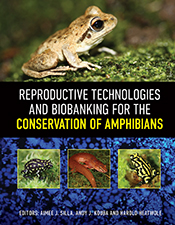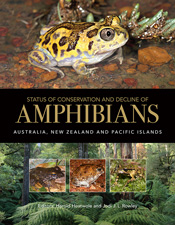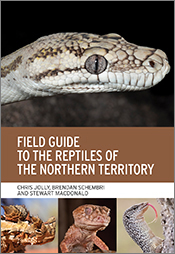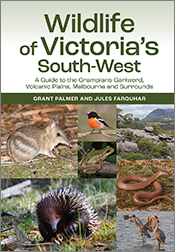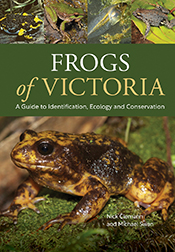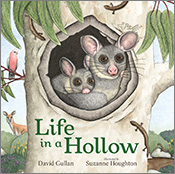Reproductive Technologies and Biobanking for the Conservation of Amphibians
Edited by: Aimee J Silla, Andy J Kouba, Harold Heatwole
Integrating reproductive technologies into amphibian conservation breeding programs.
How to decelerate loss of global biodiversity is one of the greatest challenges of our generation. Reproductive technologies have enormous potential to assist the recovery of species by enhancing reproductive output, facilitating genetic management, and supporting reintroduction of threatened species. Of particular value are cryopreservation technologies coupled with the establishment of global gene banks to conserve, in perpetuity, the remaining extant genetic diversity of threatened amphibians. + Full description
Reproductive Technologies and Biobanking for the Conservation of Amphibians brings together leading experts in the field to provide a comprehensive overview of current best practices, summarise technological advancements, and present a framework for facilitating the integration of reproductive technologies and biobanking into conservation breeding programs for threatened amphibians. It is an invaluable reference for the next generation of conservation practitioners: captive breeding facilities, researchers, and policy-makers involved with biodiversity conservation.
- Short descriptionNews
Sales in Australia and New Zealand only. Elsewhere, this title is available through CRC Press (external link).
Reviews
"Helpful charts, tables and a section of colour plates complement the text, unpacking some of the more technical aspects of amphibian reproductive technologies and processes. Across Australia, many researchers and organisations are dedicated to progressing amphibian conservation, and this book will be an invaluable resource for the next generation of conservation practitioners whether involved with captive breeding facilities, research or conservation policy development."
Wildlife Health Australia, 19 September 2022
"[Reproductive Technologies and Biobanking for the Conservation of Amphibians] It is an invaluable reference for the next generation of conservation practitioners: captive breeding facilities, researchers, and policymakers involved with biodiversity conservation."
Australian Wildlife Volume 1, Summer 2023
Details
Hardback | October 2022 | $180.00ISBN: 9781486313334 | 248 pages | 270 x 210 mm
Publisher: CSIRO Publishing
B&W photographs, Colour plates, Illustrations
ePDF | October 2022
ISBN: 9781486313341
Publisher: CSIRO Publishing
Available from eRetailers
ePUB | October 2022
ISBN: 9781486313358
Publisher: CSIRO Publishing
Available from eRetailers
Features
- Comprehensive sourcebook for use of reproductive technologies and biobanking in amphibian conservation.
- Explores an extensive range of topics that will act as a platform for the continued advancement of reproductive technologies as tools for amphibian conservation.
- This book is Volume 12 of the Amphibian Biology series
Contents
DedicationList of contributors
Preface
Volumes in the series Amphibian Biology
1. Integrating reproductive technologies into the conservation toolbox for the recovery of amphibian species
2. Status of global amphibian declines and the prioritisation of species for captive breeding
3. Methods of identifying the sex of amphibians and of conditioning captive brood stock for assisted reproduction
Colour plates
4. Hormonal control of amphibian reproduction
5. Non-invasive monitoring of stress physiology during management and breeding of amphibians in captivity
6. Ultrasonography to assess female reproductive status and inform hormonally induced ovulation
7. Protocols for hormonally induced spermiation, and the cold storage, activation, and assessment of amphibian sperm
8. Genetic management of threatened amphibians: using artificial fertilisation technologies to facilitate genetic rescue and assisted gene flow
9. Cryopreservation of amphibian genomes: targeting the Holy Grail, cryopreservation of maternal-haploid and embryonic-diploid genomes
10. Culturing and biobanking of amphibian cell lines for conservation applications
11. Linking in situ and ex situ populations of threatened amphibian species using genome resource banks
12. Genome resource banks as a tool for amphibian conservation
Appendix
Index
Authors
Aimee J. Silla is an Associate Research Fellow at the University of Wollongong and co-head of the Evolution and Assisted Reproduction Laboratory. Her integrative research advancing reproductive technologies is promoting new directions for threatened species recovery.
Andy J. Kouba is the Wildlife, Fisheries and Aquaculture Department Head at Mississippi State University, Executive Director of the Center for Human-Wildlife Interactions, and Co-Director of the National Amphibian Genome Bank.
Harold Heatwole has four doctorates and holds Professorships at North Carolina State University and University of New England. He researches herpetology, biogeography, polar ecosystems, vegetation dynamics, as well as ants, tardigrades, and seabirds. Harold Heatwole was also a co-editor of Volume 11, Part 6 of the Amphibian Biology series, Status of Conservation and Decline of Amphibians: Australia, New Zealand, and Pacific Islands.
Contributors:
Aimee J. Silla, Andy J. Kouba, Harold Heatwole, Phillip G. Byrne, John Clulow, Simon Clulow, Barbara Fraser, Jennifer M. Germano, Katherine M. Graham, Tyrone B. Hayes, Marlys L. Houck, Kevin Johnson, Allison R. Julien, Carrie K. Kouba, Cecilia J. Langhorne, Luke J. Linhoff, Joseph R. Mendelson III, Frank C. Molinia, Edward J. Narayan, Harsh K. Pahuja, Brianna H. Raven, Julie Strand, Vance L. Trudeau, Rose Upton.

